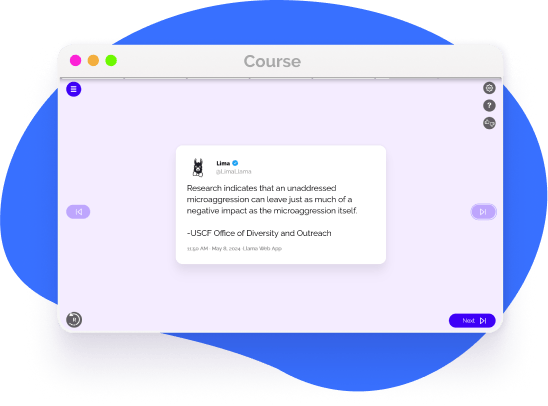How to Combat Microaggressions with Training
We all commit a microaggression at some point in our lives, personally or professionally, and in most cases, when we do, we are not made aware of it. In this chapter, we will explore ways to disrupt and challenge when we see a microaggression.

Supporting Others with Microinterventions
Many people are affected by daily instances of social and environmental microaggressions. Microinterventions are actions we can take to help intervene in these experiences. One goal of microinterventions is to help make the unconscious thoughts and actions of others become more conscious, since microaggressions are often reduced when people become more self-aware. Other goals of microinterventions include educating offenders and helping others seek external support when needed, such as through HR or an employee resource group.

What if you commit a microaggression?
If we are called out for committing a microaggression, it can be hard to hear and even harder to have a discussion about it. And if we see a microaggression and decide to say something, this can also be a tough conversation to have. But, it is important to be able to sit with the discomfort that one may feel and be open to exploring strategies for having these difficult conversations.

Microinterventions show targets that they are valued members of the community, affirm their identity, demonstrate support and encouragement, and help them feel that they are not alone. If you decide upon a direct approach for intervening in a microaggression, there are some strategies that you can use. Let’s look at four of them now that are known as the 4 R's.
The second R is Reframe. This strategy involves looking at the microaggressive comment or behavior from a different angle to help the offender see things from a different perspective and better understand their thoughts and actions. For example, you might say: "Could there be another way to look at this?" or “What would happen if....”
The third R stands for Redirect. This strategy involves drawing attention away from the targeted person or community. Shifting the focus takes the spotlight off of the target and it can help diffuse the situation. And the fourth R is Revisit. This strategy involves addressing the microaggression with the offender at a later time. For example, you might say: “Let’s rewind a few minutes…”
The first is Reflect. This strategy involves mirroring or paraphrasing back to the offender your interpretation of the microaggression. For example, you might say: "It sounds like you think..." or “What I’m hearing is...is that correct?” This conveys to the offender your willingness to understand what was said, and it can help reduce defensiveness.

Microaffirmations can provide support for isolated coworkers
Some examples of microinterventions include directly addressing the offender of the microaggression, using a personal experience as an approach to discussing the microaggression, redirecting the focus of the microaggression, and using microaffirmations to help validate the experiences of targets. Microaffirmations are small acts that foster inclusion and support for individuals who may feel isolated or invisible in an environment. Some examples of microaffirmations include starting a fundraiser, hiring more diverse candidates, or sponsoring a department project with a local organization.
Questions to ask Before a Microintervention
If you are sure or relatively sure that someone has committed a microaggression and you want to intervene with a direct approach, there are some questions to ask yourself before you take action. According to Dr. Kevin Nadal, professor of psychology at John Jay College, there are five helpful questions to consider:
Here are some myths to look out for:
- -
Will I be in physical danger if I respond?
- -
Might the offender become defensive, leading to an argument?
- -
Will an intervention have an effect on my relationship with the offender?
- -
If I decide not to intervene, will I regret it?
- -
If I decide not to intervene, will my silence be interpreted as approval of the offender's words or actions?

Maintain a safe workplace with microintervention training
When employees witness a microaggression, and want to say something to the offender, it can sometimes feel awkward to both parties. The method of communication is just as critical as the information being delivered. Even if it is coming from a good place, tone and appearance of the communication could be expressing something very different. EasyLlama Microaggressions training can help your employees understand how best to stage a microintervention when witnessing an upsetting event, making a huge difference in the delivery and impact of their message and providing a safer workplace for everyone involved.

Helping over 8,000 organizations create a safer, more productive workplace
Terms such as prejudice, unconscious bias, microassault, microinsult, and microinvalidation are thoroughly explored to facilitate employee understanding, therefore guiding learners to meet your organization's DEI objectives.





















